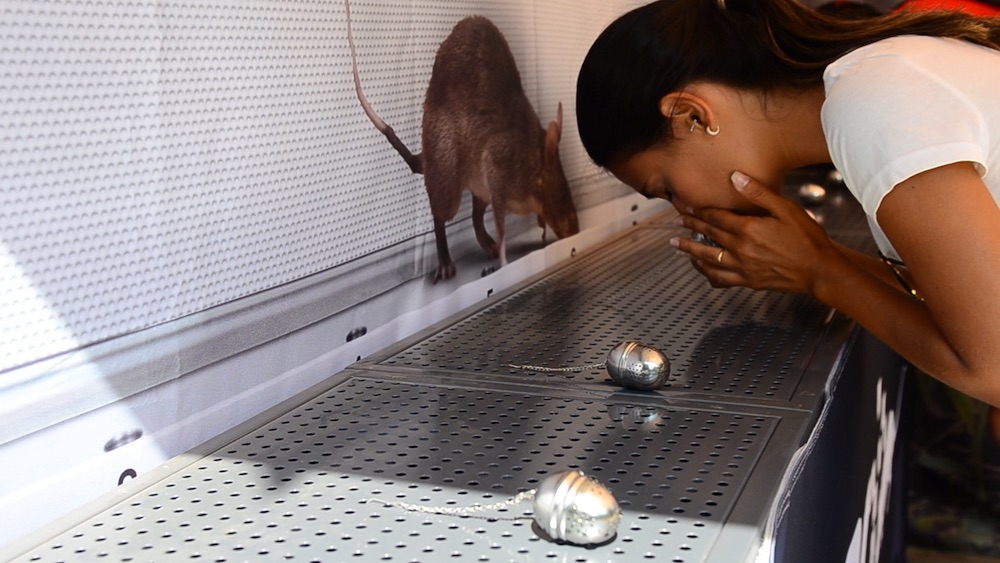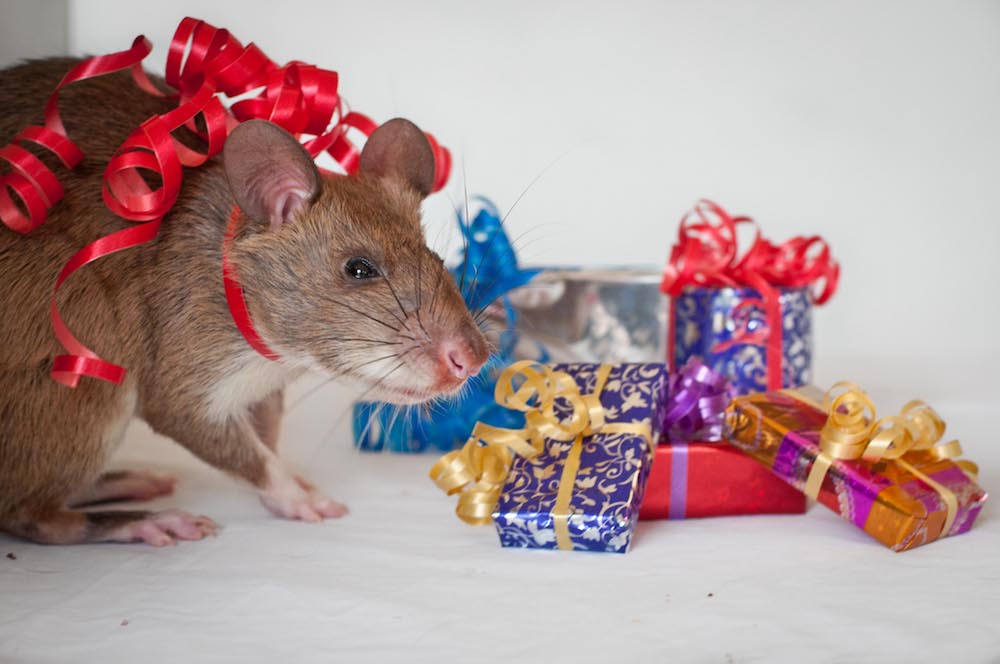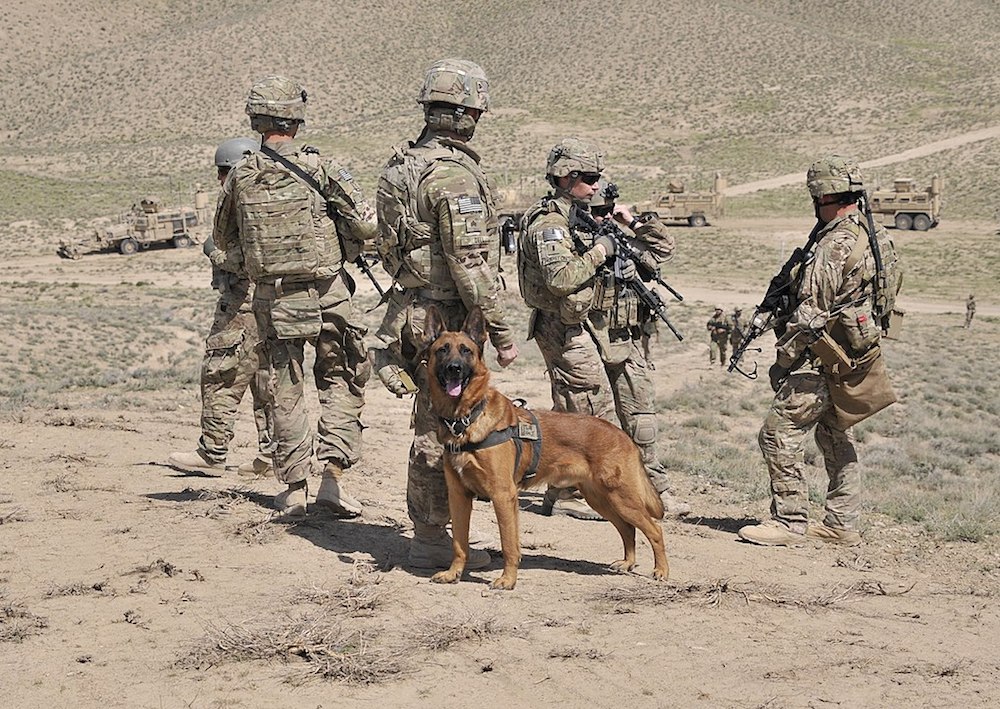How Rats Are Overturning Decades of Military Norms

At the third stop at the APOPO Visitor Center in Siem Reap, Cambodia, the tour guide announces, “We have a contest!”
He flourishes his hand and displays a metal tea ball filled with fragrant spices. “Now, you will all pretend to be rats!”
Behind the tour guide is a table with a blue cloth on it and 10 identical tea balls chained to a wall. Next to them is a photo of a Gambian pouched rat in mid-step, her nose bent. The tour guide offers visitors the tea ball that he’s been holding.
Each person takes in the pungent spice, an earthy scent with a sour note. The guide explains: “When you smell this, it would be helpful if you rub your noses or blow your noses. This is why you see the rats groom their whiskers and rub their faces with their paws—so they can be more precise when they smell.”
The other visitors and I follow this advice. The children screech with laughter when one blows snot onto the ground. We line up and approach the table one by one and sniff the tea balls.
Each ball gives off the fresh spicy aroma. The center takes this opportunity to educate visitors about its Cambodian setting: Some of the balls contain famous Kampot peppercorn (known as the best peppercorn in the world, grown only in the Kampot province), Southeast Asian red chili, and curry. “OK, so show me which number ball matches the one I gave you.”
I raise five fingers.
“Yes! Five is correct!”
The guide leads everyone in a round of applause.
“Since you have succeeded, we will now ask you to stay and help us in the minefields. And we will pay you in bananas,” he says. “For those who guessed a number besides five, we will thank you for coming and ask you to leave.”
A murmur of laughter rises at the joke. The contest is not only a game but also an audition. The nongovernmental organization APOPO is taking its visitors on a tour to imagine what it is like to be a rat.
APOPO, a Belgian NGO whose acronym translates to Anti-Personnel Landmines Removal Product Development, was founded with the mission of using pet rodents to detect land mines and other explosives. The NGO’s HeroRATs, with their acute sense of smell, have been so successful that the rodents are now seen as competition for the more traditionally used military dogs for mine clearance. In 2015, I conducted fieldwork alongside the first rat handler trainees in Cambodia to work with imported land mine detection rats, a continuation of my years of research in land mine action industries in Southeast Asia.
As an anthropologist who has conducted fieldwork with deminers since 2010, I had grown accustomed to the militarism of these organizations. The people who work in the land mine action industry are typically former soldiers, and they follow military structures, calling their teams “platoons” and, in Cambodia, wearing uniforms inspired by military regalia. The rats presented a puzzle, though: No matter how much the NGO tried to make them “heroic,” they were either cartoonish or pest-like, given their historical connotations.
Yet through their loveable rat attributes, the animals have largely disrupted the militarism long associated with land mine detection platoons—a shift that could over time undo the military stigma that surrounds land mine detectors in Cambodia. The rat itself has arguably altered not only the ways in which land mine detection groups portray their animal helpers, but it has also restructured organizational practices and ways people in land mine detection understand their own work.
Before the arrival of the APOPO rats in Cambodia, organizations at the head of military decontamination did not have tourist centers where visitors would meet a deminer (those tasked with locating and detonating land mines) and their land mine detection animal. The more common detection animal, the dog, used as a military aid animal throughout the world since WWII and now widely implemented for mine action in 23 mine-contaminated countries, was never presented as a cuddly companion but rather a proud and aloof animal. Mine clearance experts called such animal aids “biological technologies,” keeping their practical roles very separate from personal human experiences. This changed after APOPO’s success story with rats in countries like Mozambique, Tanzania, and Cambodia.
Through their loveable rat attributes, the animals have largely disrupted the militarism long associated with land mine detection platoons.
Cambodia is contaminated with millions of unexploded ordnances dropped as cluster bombs by the U.S. during the Vietnam War. In addition, millions of land mines were buried throughout the country during a series of civil wars from the 1970s–1990s. Conscripted soldiers who planted these land mines are sometimes hired by today’s state military to detect and detonate them. Moreover, the largest land mine detection organization, the Cambodian Mine Action Centre, is part of the military branch of government. A land mine detection organization, governmental or nongovernmental, benefits from its connections to military expertise, but sometimes this connection gives them a reputation among civilians. This tangled history—with conscripted soldiers who fought against one another in various civil wars—affects the ways in which the former soldiers relate to one another. As a result, the minefield as a workplace is a transformed battlefield for the former combatants turned deminers.
The fact that most Cambodian deminers have combat experience affects the way people perceive deminers and the organizations they work for. When I tell civilians that I worked in minefields with demining platoons, I often pick up on a sense of distrust—an irony, given that land mines are responsible for Cambodia having over 40,000 amputees, making it the country with the highest ratio of land mine amputees per capita in the world.
“There’s no difference between them and the military police,” villagers told me on several occasions. A young woman once said, with a giggle, “We used to all stand outside the minefield and yell, ‘Ghost head, ghost head, ghost head!’ I don’t think they liked that, though.”
The insult references bright red minefield warning signs of skull and crossbones, and an association with death and destruction. While the deminers risk their lives to clear lands for cultivation, they are ultimately former soldiers who are connected to governmental power.
Such a military stigma is not unwarranted. In a context where government operations are rumored to grab village lands, disappear people who disagree with the ruling party, and quell legitimate protests, deminers carry a stigma of military corruption. Some rumors even accuse deminers disguised as military police to have arrested environmental activists protesting dam building and logging.
Enter the land mine detection rat. When APOPO convinced the Cambodian state to use rats for land mine detection, they lauded the rats as an innovative technology for land mine detection. Rats are less expensive and more precise than dogs, and metal detectors, the more mainstream technology, result in a lot of false positives since they do not detect only explosive powder.
APOPO uses Gambian pouched rats, also known as giant African rats by their size, an animal that can be as heavy as 3 pounds and as long as 3 feet. While large for rats, they are weightless for the land mines and can walk safely across a live minefield. For the first nine months of their eight years of life, rats-in-training are taught to smell explosive powder using a clicker technique and positive intermittent reinforcement (not unlike dog training). In the field, the rats learn to scratch the soil twice when they detect explosive powder in the ground. Human handlers then mark that scratched point on a map of the minefield.
Early on in Cambodia, the rat stood out as a welcome change from the heavily militarized materials and practices on the minefield. The rat’s attributes disarm more than the landscape. The animals follow the footsteps and taps of their human handlers. They crawl up people’s arms to snuggle and nibble their necks—an affectionate relationship that leads to a very different atmosphere compared to rat-free minefields. At times, even former enemies laugh with one another about their newfound “friends.”
Rats have been so successful that the rodents are now seen as competition for the more traditionally used military dogs for mine clearance.
“At first,” Chamroeun, a deminer and former soldier and a friend of mine, told me, “I thought of rats as pests, but now I think of them as my very best friends.”
His was a common sentiment among the demining platoon whose members were largely former soldiers turned deminers; they caressed the rats each morning to apply sunblock on their ears, feet, and tails, and often spoke of love for the rats. One woman referred to Issac, a monstrous, lumbering rat, as her “little sister,” using the diminutive nickname she would typically reserve for a younger female-identifying friend. The deminers joked together about how much they loved their rats and how much their rats loved them. Theirs was serious, military, and mostly tedious daily work—step by step, in uniforms that recalled their former lives at war. And yet the rats softened the ways the deminers interacted with the work and with one another. They cuddled the rats and laughed about their mannerisms and cuteness.
Such interactions lent themselves well to APOPO’s publicity campaigns. The NGO even strategized on how to boost its social media presence by starting something called “Raturday.” Each Saturday, they post a photo of one of their rats, often in holiday-appropriate garb to celebrate their cuteness.
Before the rats were enlisted, demining organizations attracted donors by relying on portraying the injuries of land mine victims or the heroism of the soldiers who risked their lives to decontaminate the landscapes. Reports provided to organizational funding streams often included colorful images of amputees and photos of workers in their military-inspired uniforms. APOPO, though, leans into the rats’ cuteness and lovability, often portraying their “HeroRAT” in its promotional materials, helping to further upend the militarism typically found in mine clearance agencies.
Now, five years after the rats were introduced, the government and NGO partnership has deployed dozens more mine detection rat platoons throughout Cambodia. In 2017, APOPO founded the APOPO Visitor Center, complete with its public-facing rat demonstrations. This is unprecedented for a mine clearance organization. When visiting a land mine detection center in Cambodia before APOPO, one usually found a serious bureau with military uniformed personnel, not vividly painted murals and adorable animals to admire.
But the rodent program’s unprecedented success raises a fair question: How did the rat manage to demilitarize land mine detection organizations? That is, why not the dog, who is arguably more lovable and whose extensive experience in land mine detection should give canines a leg up?
The answer is partly about APOPO’s strategies for acquiring donations to supplement highly sought-after grants. And the answer partly lies in the rat’s attributes and the stories we tell about them compared with those of dogs.
Rats have been known to be laboratory animals, cartoons, and pests. In the legend of the Chinese zodiac, the Jade Emperor called for a race and part of that race entailed crossing a river. The rat could not swim, so it convinced the ox to help him traverse it. At the very last moment, he traveled to the ox’s nose, putting himself in first place and the ox in second. We know the rat here as a clever beast but also kind of an asshole. The rat is generally not known to us as an honorable companion and certainly not one suited for military aid.
Military dogs, on the other hand, have been a familiar sight throughout human history. Take, for instance, the Belgian Malinois, a sleek dog traditionally used in land mine detection. This breed was selected because of its intelligence and loyalty, but one can’t help but suspect that its graceful appearance—with wolf-like ears and pointy noses—also played a role. Some studies suggest that Labrador retrievers or Basset hounds would be just as good, if not better, at land mine detection as the Malinois, even though they have never been widely implemented. But those breeds, like the rats, don’t fit in as well with the military aesthetic of the minefield.
Yet for all their charisma and grace, recent Malinois land mine detection promotional materials—featuring cute puppies and wagging tongues—seem to be trying to play off the success of the rats. While the APOPO staff told me that the dogs were fine for “certain minefields,” they seemed intent on showing that the rats had advantages over the dogs due to their smaller size, which makes them more precise. In addition, rats aren’t loyal to only one handler, which gives them an advantage over the Malinois breed’s strong tendency for loyalty.
But perhaps most importantly, the HeroRATs seem to turn the traditional military nature of land mine operations on its head. APOPO takes every opportunity to capitalize on the playfulness of the rodents, holding HeroRAT “adoptions” in exchange for monthly or annual donations and sending adopters an email containing a “Top Secret File.” Demilitarization, the APOPO staff told me, is key to the success of land mine detection: They explained that military procedures, with their dependence on hierarchy and redundant chains of command, slow the detection process, putting more lives at risk.
Over time, perhaps rats will also help the children see deminers in a new light so they no longer jeer at them from the sidelines, calling them “Ghost heads.” But it will take time for these decades-old perspectives to shift because such stigmas have more to do with confidence in the state government. Cute and loveable animals only go so far: They cannot overcome civilian villagers’ suspicions of state violence.
Yet the rats hold the potential to change the nature of the land mine action industry itself, empowering its employees to let go of their militarized pasts and allowing the land mine detection agencies to emphasize a new aesthetic sensibility beyond militarism. Now, in photographs on land mine action websites, deminers not only stare proudly into the distance but also laugh good-naturedly as rats tickle their necks.
On the minefield, the rats ease militarism in the deminers’ daily work environment. The deminers bond with one another over their friendship with rats. Together, they work diligently in the life-saving process of searching for land mines.




































